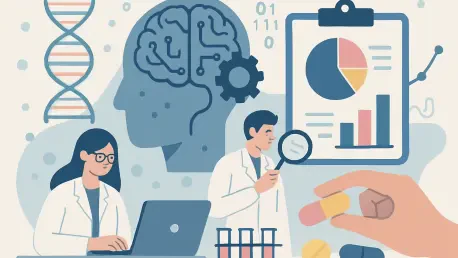The world of clinical trials is experiencing a profound transformation, fueled by the integration of real-world data (RWD) and artificial intelligence (AI), which together are redefining how medical research is conducted and how patient care is delivered. RWD, derived from everyday healthcare interactions outside the rigid framework of traditional trials, captures a wealth of information from electronic health records, clinician notes, and treatment histories. This data offers an authentic glimpse into patient experiences across diverse populations, revealing nuances that controlled studies often miss. As the healthcare industry grapples with rising costs and lengthy trial timelines, the promise of RWD lies in its ability to provide actionable insights, while AI serves as the key to unlocking the potential of vast, often chaotic datasets. This powerful combination is not just a technological advancement but a fundamental shift toward more inclusive, efficient, and patient-focused research methodologies.
The Power of Real-World Data in Healthcare
Unlocking a Broader Patient Perspective
The advent of RWD marks a pivotal change in how researchers understand health outcomes, moving beyond the confines of controlled clinical environments to embrace the messiness of real-life patient journeys. Unlike traditional trials that often involve limited, homogeneous groups under strict protocols, RWD pulls from a wide array of sources such as hospital records, lab results, and even patient-reported outcomes. This approach paints a fuller picture of how treatments perform across varied demographics, geographies, and conditions. It highlights disparities in care, uncovers unexpected responses to therapies, and sheds light on long-term effects that might never surface in a short-term study. By reflecting the true complexity of healthcare delivery, RWD enables a deeper grasp of disease progression and treatment efficacy, setting the stage for innovations that resonate with the realities faced by patients every day.
At the heart of harnessing RWD lies the challenge of its unstructured nature, a hurdle that AI is uniquely equipped to overcome with remarkable precision. Much of this data exists in formats that are not easily analyzed, such as free-text clinician notes or inconsistent record-keeping systems, making manual processing impractical. Technologies like machine learning (ML) and natural language processing (NLP) step in to identify patterns, extract relevant information, and transform raw inputs into structured, usable evidence known as real-world evidence (RWE). These tools can detect correlations between treatments and outcomes that might otherwise remain hidden, enabling researchers to build comprehensive datasets. The role of AI here is not merely technical but transformative, turning what was once an overwhelming flood of information into a streamlined resource that drives smarter, evidence-based decisions in clinical research.
Enhancing Trial Efficiency and Access
While AI provides the analytical muscle to process RWD, the importance of human expertise cannot be overstated in ensuring the integrity and relevance of the resulting insights. Physicians, nurses, data scientists, and technologists collaborate to validate AI outputs, refine algorithms, and address potential biases that could skew results. This partnership is essential for curating high-quality, disease-specific datasets that accurately represent diverse patient populations. Human oversight ensures that cultural, ethical, and clinical nuances are considered, preventing over-reliance on automated systems that might miss critical context. For instance, a clinician’s input can help interpret ambiguous data points, while data scientists continuously update models to reflect evolving healthcare trends. This synergy between technology and human judgment is fundamental to building trust in RWD-driven research and ensuring that it translates into meaningful improvements for patient care.
One of the most tangible benefits of RWD is its capacity to streamline clinical trials, cutting both costs and timelines while enhancing patient access to cutting-edge research. By leveraging real-world insights, researchers can refine eligibility criteria to target the right participants, accelerate recruitment processes, and monitor outcomes over extended periods with greater accuracy. This data-driven approach minimizes common setbacks such as mismatched enrollment or unanticipated side effects, which often derail traditional trials. Moreover, RWD facilitates decentralized trial models, allowing patients in remote or underserved areas to participate without the burden of frequent travel to study sites. The result is a more inclusive, efficient research process that prioritizes patient convenience and delivers results faster, ultimately bringing therapies to market with reduced financial strain on sponsors and healthcare systems alike.
Expanding Applications and Industry Impact
Beyond Trials: Diverse Uses of RWD
The utility of RWD extends far beyond the boundaries of clinical trial design, permeating various facets of healthcare research and decision-making with profound implications. It plays a crucial role in retrospective and prospective studies, comparative effectiveness research (CER), and health economics and outcomes research (HEOR), providing a robust foundation for evaluating treatment impacts across different contexts. RWD also aids in market targeting for commercialization, helping companies identify where therapies are most needed. Its ability to offer a longitudinal perspective on chronic diseases is particularly valuable, as it reveals treatment gaps, patient adherence challenges, and even rare side effects that might escape detection in shorter, controlled studies. By capturing these insights, RWD informs strategies for ongoing care and supports the development of interventions that address real, unmet needs in patient populations.
Another critical dimension of RWD is its contribution to personalized medicine, where treatments are tailored to individual patient profiles based on granular data insights. For chronic conditions like diabetes or cardiovascular disease, RWD can track how comorbidities, lifestyle factors, and genetic predispositions influence therapy outcomes over time. This level of detail enables researchers to design studies that account for such variables, ensuring that findings are relevant to specific subgroups rather than a generalized cohort. Additionally, RWD helps uncover disparities in healthcare delivery, highlighting areas where access to care or treatment efficacy varies significantly. By integrating these findings into research and policy, stakeholders can work toward reducing inequities and fostering a more adaptive, patient-centric healthcare landscape that responds to the unique challenges faced by different communities.
Regulatory and Stakeholder Adoption
The growing acceptance of RWD across the healthcare ecosystem signals a seismic shift in how clinical research is validated and applied, with regulatory bodies playing a pivotal role in this transition. The U.S. Food and Drug Administration (FDA) has issued guidance on incorporating RWD into drug development, recognizing its potential to complement traditional randomized clinical trials. This regulatory backing has spurred a surge in use cases, from post-market surveillance to assessing long-term safety profiles of therapies. For drug developers, RWD offers a pathway to accelerate innovation by identifying new indications for existing treatments and supporting faster approvals through robust RWE. This evolving framework not only validates the importance of RWD but also encourages its integration into standard practices, paving the way for a future where data from real-world settings is a cornerstone of medical advancement.
Equally significant is the value RWD brings to other stakeholders, such as health insurers and healthcare providers, who rely on RWE to make informed decisions about patient support and reimbursement. Insurers can use this evidence to evaluate the cost-effectiveness of therapies, ensuring that coverage aligns with demonstrated outcomes in real-world populations. Meanwhile, providers gain insights into how treatments perform outside clinical settings, enabling them to refine care protocols and improve patient outcomes. This broad adoption underscores the versatility of RWD, as it bridges gaps between research, policy, and practice. By fostering collaboration among regulators, sponsors, and payers, RWD creates a cohesive environment where data-driven insights enhance every facet of healthcare delivery, from therapy development to equitable access for patients across diverse settings.
Trends Shaping the Future of Clinical Research
Driving Precision and Personalization
A defining trend in modern healthcare is the move toward precision medicine, a paradigm where RWD and AI converge to tailor trials and treatments to individual patient needs with unprecedented accuracy. By analyzing data on disease variations, genetic markers, and coexisting conditions, RWD fills critical knowledge gaps that traditional studies often overlook. This granular approach allows researchers to design protocols that target specific subgroups, ensuring therapies are both effective and relevant to those who need them most. AI amplifies this capability by identifying subtle correlations within complex datasets, enabling a level of customization that was once unimaginable. As a result, the healthcare industry is shifting from a one-size-fits-all model to a more nuanced, personalized framework, where patient diversity drives innovation and outcomes are optimized for real-world impact.
This push for personalization also aligns with a broader industry imperative to enhance competitiveness in a global market, where data-driven strategies are becoming a key differentiator. Life sciences companies leveraging RWD can better understand how therapies perform across varied populations, from urban centers to rural communities, and adjust their approaches accordingly. This adaptability not only improves trial success rates but also strengthens market positioning by addressing unmet needs with precision. Furthermore, the integration of RWD supports the development of digital health tools and predictive models, which forecast patient responses and guide clinical decisions. As these technologies mature, they promise to redefine healthcare delivery, making it more proactive, equitable, and aligned with the unique characteristics of each patient, ultimately transforming the landscape of medical research.
Balancing Technology with Human Insight
The transformative power of AI in processing RWD is undeniable, yet its success hinges on a delicate balance with human oversight to ensure ethical and effective outcomes in clinical research. While algorithms excel at handling vast, unstructured datasets and uncovering hidden patterns, they are not infallible and can perpetuate biases if left unchecked. Human experts, including clinicians and data scientists, provide the necessary context to interpret findings, validate results, and refine models over time. This collaborative approach mitigates risks such as overgeneralization or misinterpretation of data, ensuring that RWE remains reliable and applicable to real-world scenarios. The emphasis on human involvement also fosters trust among stakeholders, reinforcing the credibility of AI-driven insights as they are applied to trial design and patient care.
Looking back, the journey of integrating RWD and AI into clinical research reflects a remarkable blend of innovation and caution, as the industry navigated the complexities of technology and ethics. The commitment to combining cutting-edge tools with expert judgment proved essential in overcoming early challenges, such as data quality issues and regulatory uncertainties. Moving forward, the focus should remain on strengthening this partnership through ongoing training for professionals and investment in robust validation processes. Stakeholders must also prioritize transparency in how RWD is used, ensuring patients and providers understand its role in shaping healthcare. By fostering dialogue between technologists, researchers, and regulators, the field can continue to evolve responsibly, harnessing the full potential of data-driven approaches to deliver therapies that are not only innovative but also deeply attuned to the needs of diverse populations.









